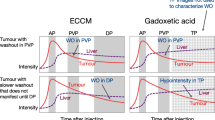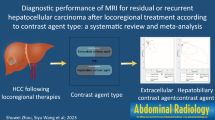Abstract
Objective
To assess whether reticular hypointensity on hepatobiliary phase images of gadoxetic acid-enhanced magnetic resonance imaging (EOB-MRI) is a diagnostic finding of sinusoidal obstruction syndrome (SOS) in patients with hepatic metastases who have undergone chemotherapy.
Methods
We retrospectively analysed EOB-MRI of 42 patients who had undergone chemotherapy before hepatic resection of colorectal hepatic metastases. Two radiologists, who were unaware of whether or not the patients had SOS, reviewed the hepatobiliary phase images to determine the presence of hypointense reticulation in the liver using a 5-point scale. The sensitivity, specificity and area under the receiver operating characteristics curve (Az) were calculated for each reviewer.
Results
The sensitivity, specificity and Az for the diagnosis of SOS were 75%, 100% and 0.957 for reader 1 and 75%, 96.2% and 0.936 for reader 2, respectively. In one patient who received a false-positive diagnosis by one reader, there was sinusoidal fibrosis on histological examination, but not diagnostic for SOS. False-negative diagnosis occurred in four patients for both readers; histology of these patients showed minimal and localised sinusoidal congestion and fibrosis.
Conclusions
Reticular hypointensity on hepatobiliary phase images of EOB-MRI is highly specific for the diagnosis of SOS in patients with treated colorectal hepatic metastases.
Key Points
• Gadoxetic acid enhanced magnetic resonance imaging (EOB-MRI) can identify the sinusoidal obstruction syndrome (SOS)
• The diagnosis can be achieved with high specificity and good interobserver agreement.
• SOS typically demonstrates diffuse hypointensity on hepatobiliary phase images on EOB-MRI.
• EOB-MRI may be falsely negative in patients with minimal degree of SOS.




Similar content being viewed by others
References
Rubbia-Brandt L, Audard V, Sartoretti P et al (2004) Severe hepatic sinusoidal obstruction associated with oxaliplatin-based chemotherapy in patients with metastatic colorectal cancer. Ann Oncol 15:460–466
Nakano H, Oussoultzoglou E, Rosso E et al (2008) Sinusoidal injury increases morbidity after major hepatectomy in patients with colorectal liver metastases receiving preoperative chemotherapy. Ann Surg 247:118–124
Mehta NN, Ravikumar R, Coldham CA et al (2008) Effect of preoperative chemotherapy on liver resection for colorectal liver metastases. Eur J Surg Oncol 34:782–786
Torrisi JM, Schwartz LH, Gollub MJ, Ginsberg MS, Bosl GJ, Hricak H (2011) CT findings of chemotherapy-induced toxicity: what radiologists need to know about the clinical and radiologic manifestations of chemotherapy toxicity. Radiology 258:41–56
DeLeve LD, Shulman HM, McDonald GB (2002) Toxic injury to hepatic sinusoids: sinusoidal obstruction syndrome (veno-occlusive disease). Semin Liver Dis 22:27–42
Aloia T, Sebagh M, Plasse M et al (2006) Liver histology and surgical outcomes after preoperative chemotherapy with fluorouracil plus oxaliplatin in colorectal cancer liver metastases. J Clin Oncol 24:4983–4990
Kandutsch S, Klinger M, Hacker S, Wrba F, Gruenberger B, Gruenberger T (2008) Patterns of hepatotoxicity after chemotherapy for colorectal cancer liver metastases. Eur J Surg Oncol 34:1231–1236
Morris-Stiff G, Tan YM, Vauthey JN (2008) Hepatic complications following preoperative chemotherapy with oxaliplatin or irinotecan for hepatic colorectal metastases. Eur J Surg Oncol 34:609–614
Tisman G, MacDonald D, Shindell N et al (2004) Oxaliplatin toxicity masquerading as recurrent colon cancer. J Clin Oncol 22:3202–3204
Ishizaki T, Abe T, Koyanagi Y et al (2007) A case of liver failure associated with liver damage due to mFOLFOX 6 after resection for multiple liver metastases from colorectal cancer. Gan To Kagaku Ryoho 34:945–948
Ward J, Guthrie JA, Sheridan MB et al (2008) Sinusoidal obstructive syndrome diagnosed with superparamagnetic iron oxide-enhanced magnetic resonance imaging in patients with chemotherapy-treated colorectal liver metastases. J Clin Oncol 26:4304–4310
O’Rourke TR, Welsh FK, Tekkis PP et al (2009) Accuracy of liver-specific magnetic resonance imaging as a predictor of chemotherapy-associated hepatic cellular injury prior to liver resection. Eur J Surg Oncol 35:1085–1091
Weinmann HJ, Schuhmann-Giampieri G, Schmitt-Willich H, Vogler H, Frenzel T, Gries H (1991) A new lipophilic gadolinium chelate as a tissue-specific contrast medium for MRI. Magn Reson Med 22:233–237, discussion 242
Clement O, Muhler A, Vexler V, Berthezene Y, Brasch RC (1992) Gadolinium-ethoxybenzyl-DTPA, a new liver-specific magnetic resonance contrast agent. Kinetic and enhancement patterns in normal and cholestatic rats. Invest Radiol 27:612–619
Ward J, Robinson PJ, Guthrie JA et al (2005) Liver metastases in candidates for hepatic resection: comparison of helical CT and gadolinium- and SPIO-enhanced MR imaging. Radiology 237:170–180
Overman MJ, Maru DM, Charnsangavej C et al (2010) Oxaliplatin-mediated increase in spleen size as a biomarker for the development of hepatic sinusoidal injury. J Clin Oncol 28:2549–2555
Author information
Authors and Affiliations
Corresponding author
Rights and permissions
About this article
Cite this article
Shin, NY., Kim, MJ., Lim, J.S. et al. Accuracy of gadoxetic acid-enhanced magnetic resonance imaging for the diagnosis of sinusoidal obstruction syndrome in patients with chemotherapy-treated colorectal liver metastases. Eur Radiol 22, 864–871 (2012). https://doi.org/10.1007/s00330-011-2333-x
Received:
Revised:
Accepted:
Published:
Issue Date:
DOI: https://doi.org/10.1007/s00330-011-2333-x




